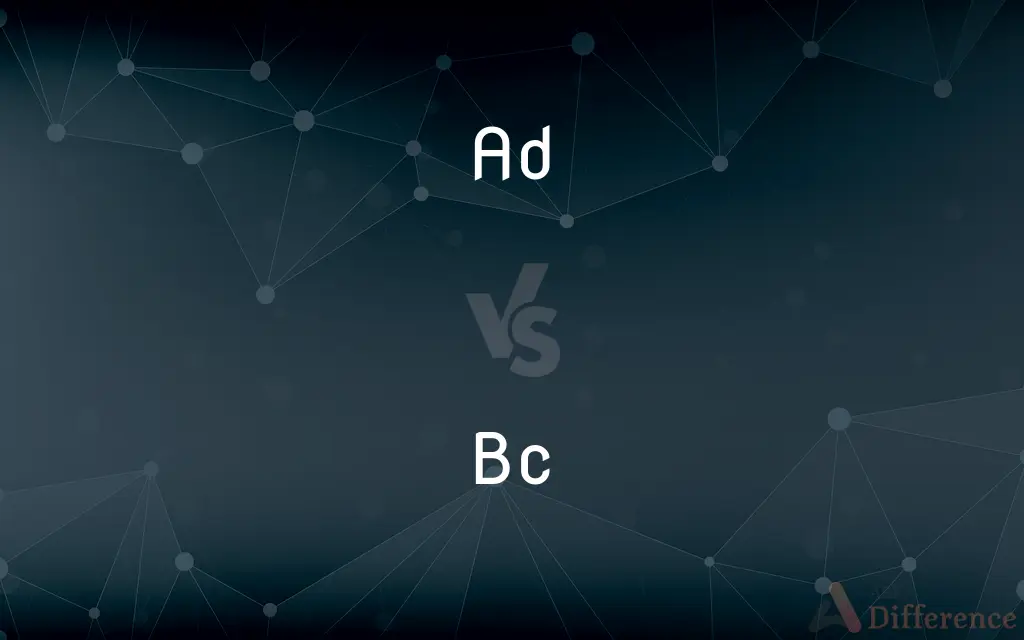AD vs. BC — What's the Difference?
By Tayyaba Rehman — Updated on September 21, 2023
"AD" stands for "Anno Domini," denoting years after Christ's birth. "BC" means "Before Christ," indicating years before his birth. Both segment time in the Gregorian calendar.

Difference Between AD and BC
Table of Contents
ADVERTISEMENT
Key Differences
"AD" and "BC" are terms used to split time into periods based on the birth of Jesus Christ. "AD" is an abbreviation for the Latin term "Anno Domini," which translates to "in the year of our Lord." It represents the years that have passed since Christ's birth. For instance, the year 500 AD means 500 years after the birth of Christ.
On the other hand, "BC" stands for "Before Christ." As the name suggests, this term refers to the years leading up to the birth of Jesus. Thus, the year 500 BC indicates 500 years before Jesus was born.
However, while "AD" and "BC" are used worldwide, in academic and scientific communities, there's a shift towards the use of BCE (Before Common Era) and CE (Common Era) as they're more neutral terms. Still, "AD" and "BC" remain widely recognized and understood.
Both "AD" and "BC" are integral to understanding historical timelines. Without these demarcations, placing historical events in their chronological context would be more challenging. They provide context to historical and future events in relation to the estimated time of Jesus's existence.
Comparison Chart
Meaning
"Anno Domini" or "in the year of our Lord."
"Before Christ."
ADVERTISEMENT
Represents
Years after the birth of Christ.
Years before the birth of Christ.
Placement
Appears before the year number (AD 2023).
Appears after the year number (300 BC).
Relative Time
Future relative to Christ's birth.
Past relative to Christ's birth.
Alternate Terms
CE (Common Era).
BCE (Before Common Era).
Compare with Definitions
Ad
Refers to years following the birth of Jesus Christ.
Rome fell in AD 476.
Bc
Abbreviation for "Before Christ."
The Pyramids of Giza were built around 2580 BC.
Ad
Often precedes the date.
AD 2023 has been a notable year.
Bc
Refers to years preceding the birth of Jesus Christ.
Socrates lived in the 5th century BC.
Ad
Latin for "Anno Domini," meaning "in the year of our Lord."
The printing press was invented in AD 1440.
Bc
Provides historical context for events before Christ.
The first Olympics were in 776 BC.
Ad
An advertisement
The latest television lager ad
Bc
Used in the Gregorian calendar to mark time before Christ's birth.
Stonehenge was constructed between 3000 BC and 2000 BC.
Ad
Short for advantage
Bc
Alternative case form of BC}} {{gloss
Ad
An advertisement.
Bc
: because.
Ad
An advantage in tennis.
Bc
(music) basso continuo
Ad
Abbreviation of advertisement
I have placed both of the ads in the newspaper as instructed.
Bc
(law enforcement) bodycam
Ad
Abbreviation of advertising
Bc
Initialism of blind carbon copy, a shortening of blind carbon copy
Ad
Abbreviation of advertiser
Bc
Before Christ; used in reckoning dates before the supposed year Christ was born, i.e. 1 a. d..
Ad
(tennis) Advantage; also, designating the left-hand side, from the player's point of view, of their half of the court, where the advantage point following a deuce is always played.
Bc
Before the Christian era; used following dates before the supposed year Christ was born;
In 200 BC
Ad
(debating) advantage
Ads and disads
Bc
Typically follows the date.
The city of Athens was founded around 500 BC.
Ad
To, toward
Ad
A public promotion of some product or service
Ad
In the Christian era; used before dates after the supposed year Christ was born;
In AD 200
Ad
Used in the Gregorian calendar to mark time post Christ's birth.
The Renaissance began in the AD 14th century.
Ad
Provides historical context for events after Christ.
The American Revolution started in AD 1775.
Common Curiosities
What do "AD" and "BC" represent?
"AD" stands for "Anno Domini" (after Christ's birth), and "BC" means "Before Christ."
Where do you place "AD" and "BC" when writing dates?
"AD" typically precedes the year (AD 2023), while "BC" follows it (300 BC).
Why use "AD" and "BC" in dating?
They provide a framework for understanding historical timelines based on Christ's birth.
Are "AD" and "BC" religious terms?
They originate from Christian tradition but are used secularly in historical contexts.
What comes first, 10 AD or 9 AD?
9 AD comes before 10 AD.
Is 1 AD immediately after 1 BC?
Yes, there's no year "0" in this dating system.
Are "AD" and "BC" used globally?
While recognized globally, some cultures use different calendars and dating systems.
Do historians still use "AD" and "BC"?
Many do, but some prefer the more neutral "CE" and "BCE."
Can "AD" be used after the date, like "BC"?
It's traditional to place "AD" before the year, but some do place it after.
Are there alternatives to "AD" and "BC"?
Yes, "CE" (Common Era) is an alternative to "AD," and "BCE" (Before Common Era) to "BC."
Share Your Discovery

Previous Comparison
Formamide vs. Formaldehyde
Next Comparison
Ruler vs. YardstickAuthor Spotlight
Written by
Tayyaba RehmanTayyaba Rehman is a distinguished writer, currently serving as a primary contributor to askdifference.com. As a researcher in semantics and etymology, Tayyaba's passion for the complexity of languages and their distinctions has found a perfect home on the platform. Tayyaba delves into the intricacies of language, distinguishing between commonly confused words and phrases, thereby providing clarity for readers worldwide.












































